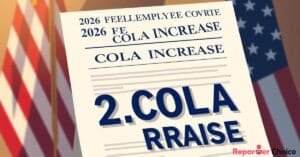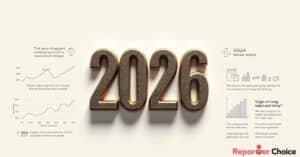2026 COLA increase for federal retirees is set at 2.8%, helping retirees keep up with rising living costs. However, not all will receive the same adjustment — some groups may see a smaller increase depending on their retirement system and eligibility factors. For official details, visit the Official COLA announcements from OPM

The cost of living adjustment (COLA) aims to protect retirees’ buying power. Some will get the full 2.8% boost. Others might see a smaller increase in their monthly benefits.
Key Takeaways
- Federal retirees will see a 2.8% COLA in 2026.
- Not all retirees will receive the full 2.8% increase.
- The COLA is designed to help retirees keep up with the rising cost of living.
- The adjustment will impact federal retirement income.
- Some retirees may see a smaller rise in their monthly benefits.
2026 COLA Increase for Federal Retirees Announced at 2.8%
Federal retirees will see a 2.8% (COLA) increase in 2026. This change is key for them as it affects their living costs. The news has been eagerly awaited by many.

Official document showing the 2026 COLA raise announcement for federal retirees, symbolizing the 2.8% cost-of-living adjustment.
Official Announcement Details and Timing
The 2.8% COLA increase for 2026 was announced on a certain date. This is a big deal for federal retirees. It helps them plan their finances better.
The announcement included the percentage increase and when it takes effect. This info is crucial for retirees to know how their benefits will change.
| Year | COLA Increase | Effective Date |
| 2026 | 2.8% | January 1, 2026 |
| 2025 | 3.2% | January 1, 2025 |
| 2024 | 2.5% | January 1, 2024 |
Key Government Officials’ Statements
Government officials have spoken about the 2026 COLA increase. They see it as important for federal retirees. Their views offer insight into the government’s stance.
Official statements say the 2.8% increase aims to help retirees with rising costs. It’s seen as a way to support their living standards.
Initial Reactions from Federal Employee Organizations
Federal employee groups have shared their thoughts on the 2.8% COLA increase. Their opinions are important as they reflect the views of many retirees.
Initial reactions vary, with some being pleased and others concerned. This shows the complexity of the issue and the different expectations among retirees.
Understanding COLA: Purpose and Importance for Retirees
The Cost-of-Living Adjustment, or COLA, is key for federal retirees. It helps keep their retirement income steady as prices rise. This way, retirees can afford the same things they could before.

What is a Cost-of-Living Adjustment?
A COLA is a boost in retirement benefits to fight inflation. It’s based on the Consumer Price Index for Urban Wage Earners and Clerical Workers (CPI-W). For 2026, the COLA is 2.8%, showing the current economic state.
Key aspects of COLA include:
- Annual adjustments to retirement benefits
- Based on CPI-W measurements
- Aims to maintain the purchasing power of retirees
Why COLAs Matter to Federal Retirees
COLAs are crucial for federal retirees. They help keep their living standards up despite inflation. For those on a fixed income, COLAs prevent their benefits from decreasing over time. For expert analysis and updates, read the Federal News Network COLA coverage.
The importance of COLA can be seen in its impact on:
- Maintaining purchasing power
- Providing a hedge against inflation
- Ensuring the real value of retirement benefits
The Legal Framework Behind COLAs
The law behind COLAs is in federal law. It’s made to safeguard the retirement income of federal workers. The adjustments are automatic, based on the CPI-W formula, to fight inflation effectively.
The legal basis for COLA includes laws that require yearly reviews and adjustments. This ensures a steady and predictable income for retirees.
Who Qualifies for the 2.8% COLA Increase in 2026
As the 2026 COLA increase gets closer, many federal retirees are wondering if they qualify. The 2.8% boost is a big help for retirees. But, it’s important to know who gets it.
Eligibility Requirements for Federal Retirees
Federal retirees under CSRS and FERS usually get the COLA increase. But, each system has its own rules.
- FERS Retirees: FERS retirees are eligible, but some might get a smaller COLA due to the “diet COLA” rule.
- CSRS Retirees: CSRS retirees get the full COLA, helping them more against inflation.
Special Considerations for Recent Retirees
Recent retirees need to know how their retirement timing affects their COLA. For example, those retiring early in 2025 might get a different COLA than those retiring later.

Exceptions and Limitations to Be Aware Of
Not all federal retirees get the 2.8% COLA increase. Some, like disability retirees or those getting survivor benefits, might have different rules.
| Retirement System | COLA Eligibility | Special Considerations |
| FERS | Eligible, potential “diet COLA” | Recent retirees, disability retirees |
| CSRS | Eligible, full COLA | Generally no “diet COLA” |
It’s key for federal retirees to understand these details to plan their finances for 2026.
FERS vs. CSRS: Different COLA Applications in 2026
As federal retirees look forward to the 2026 COLA increase, it’s important to know the difference between FERS and CSRS. The way COLA is applied to these systems impacts the retirement benefits of millions. This knowledge is crucial for planning.

FERS COLA Rules and the “Diet COLA” Effect
FERS retirees under 62 get a COLA based on inflation. But, those 62 or older face a “Diet COLA.” This means a lower COLA in high inflation years. It’s less than what CSRS annuitants get.
The “Diet COLA” is calculated differently. This results in a lower adjustment for FERS retirees. It’s key to understand this when planning finances, considering the 2026 retirement benefits update.
CSRS Full COLA Benefits Explained
CSRS retirees get the full COLA increase. Unlike FERS, they don’t face the “Diet COLA” reduction. For example, a 2.8% COLA in 2026 means a full 2.8% increase for CSRS retirees. This makes their COLA less tied to Social Security eligibility.
Mixed Retirement System Considerations
Those with both FERS and CSRS service face a more complex situation. Their annuity is split into two parts. The CSRS part gets the full COLA, while the FERS part is subject to the “Diet COLA” rules. This requires careful planning, considering the inflation and cola 2026 dynamics.
Knowing these differences is essential for navigating retirement benefits in 2026. Being informed about how your retirement system affects your COLA is crucial for financial planning.
How the 2026 COLA Increase Was Calculated
The 2026 COLA increase for federal retirees was figured out using a special formula. This formula looks at changes in the Consumer Price Index for Urban Wage Earners and Clerical Workers (CPI-W). This is key to figuring out the cost-of-living adjustment for federal retirees.
The CPI-W Formula and Measurement Period
The CPI-W formula compares the average CPI-W for the third quarter of the current year to the previous year’s third quarter. The third quarter is July, August, and September. This comparison finds the percentage change, which is then used to figure out the COLA increase.
Economic Factors Influencing the 2.8% Rate
Several economic factors led to the 2.8% COLA rate for 2026. These include inflation, wage growth, and economic stability. The CPI-W data from July to September 2025 was key in setting the COLA rate. Housing costs, energy prices, and other consumer goods prices were all considered in the CPI-W calculation.
Controversies Around the Calculation Method
There have been debates about the COLA calculation method. Some say it doesn’t really show the inflation that seniors face. They think using the Consumer Price Index for the Elderly (CPI-E) might better show what federal retirees need for cost-of-living adjustments.
Comparing the 2026 COLA to Previous Years
Looking at the 2026 COLA in the context of past trends helps federal retirees. The 2.8% increase is part of a pattern to keep retirees’ buying power steady.
Historical COLA Trends (2020-2025)
To see why the 2026 COLA matters, let’s look at trends from 2020 to 2025. Here’s a table of COLA percentages for those years:
| Year | COLA Percentage |
| 2020 | 1.6% |
| 2021 | 1.3% |
| 2022 | 5.9% |
| 2023 | 8.7% |
| 2024 | 3.2% |
| 2025 | 2.5% |
The table shows big changes in COLA percentages over the years. These changes reflect shifts in the economy, like inflation rates.
What Makes 2026 Different
The 2026 COLA of 2.8% keeps up with economic changes. This rate is a bit higher than 2025’s but lower than 2023’s peak. It’s based on the Consumer Price Index for Urban Wage Earners and Clerical Workers (CPI-W) in the third quarter of 2025.
Purchasing Power Analysis Over Time
Keeping up with the cost of living is key for federal retirees. The 2.8% COLA for 2026 is a moderate boost. But, its real impact depends on inflation.
If inflation stays steady, this COLA should help retirees keep their standard of living. Yet, if inflation goes up, retirees might still see their buying power drop.
In summary, the 2026 COLA of 2.8% is part of a trend to support federal retirees. By understanding past trends and what affects COLA rates, retirees can plan better for the future.
Impact on Different Types of Federal Retirement Benefits
The 2026 COLA increase will affect federal retirement benefits in different ways. This includes annuity payments and survivor benefits. It’s important for federal retirees to know how these changes will impact their benefits.
Effect on Basic Annuity Payments with Examples
The 2026 COLA increase of 2.8% will change basic annuity payments for federal retirees. For example, a retiree getting $50,000 a year will get $1,400 more. This brings their new annual payment to $51,400.
| Current Annual Annuity | COLA Increase | New Annual Annuity |
| $50,000 | 2.8% | $51,400 |
| $30,000 | 2.8% | $30,840 |
| $75,000 | 2.8% | $77,100 |
Impact on Survivor Benefits
Survivor benefits will also increase with the 2026 COLA. Survivors of federal retirees will get a 2.8% boost. This helps them keep up with the rising cost of living.
Disability Retirement Considerations
For those on disability retirement, the 2026 COLA increase offers some relief from inflation. But, it’s key for them to know their benefits have rules and can change.
Thrift Savings Plan and the COLA Relationship
The Thrift Savings Plan (TSP) is a big part of many federal employees’ retirement plans. The COLA increase doesn’t directly change TSP balances. But, it will affect how retirees plan for their income, including TSP withdrawals.
As federal retirees deal with the 2026 COLA increase, it’s clear it will impact many aspects of their retirement benefits. Understanding these changes helps retirees plan for their financial future.
Social Security COLA 2026: Alignment with Federal Retirement
Federal retirees are looking forward to the 2026 COLA increase. It’s important to know how it matches up with Social Security COLA changes. The COLA helps both groups keep their buying power as prices rise.
Comparison Between Federal and Social Security COLAs
The COLA for federal retirees and Social Security recipients is figured out in different ways. Federal retirees’ COLA is based on the Consumer Price Index for Urban Wage Earners and Clerical Workers (CPI-W). Social Security COLA uses a similar index but might not always be the same. Learn more about the Social Security adjustment at the Social Security COLA details for 2026
In 2026, both groups are set to get a 2.8% COLA. But, this match-up isn’t always true.
- Federal retirees under FERS might get a smaller COLA, called a “diet COLA.”
- CSRS retirees usually get the full COLA adjustment.
- Social Security recipients get COLA based on CPI-W changes.
Implications for Those Receiving Both Benefits
For federal retirees getting Social Security, knowing about the 2026 COLA is key. The match between federal retirement COLA and Social Security COLA makes budgeting easier. But, the way FERS COLA is figured out can lead to different increases for retirees.
Key considerations include:
- The difference in COLA rates between FERS and CSRS retirees.
- The effect of the COLA on retirement income.
- How the COLA changes taxes and other benefits.
Special Considerations for FERS Supplement Recipients
Federal retirees under FERS with a Special Retirement Supplement (SRS) need to know how the 2026 COLA affects them. The SRS helps until Social Security kicks in, and COLA changes can impact it.
In conclusion, the 2026 COLA increase is the same for federal retirees and Social Security recipients at 2.8%. But, the way it’s figured out and applied can affect different retirees in different ways. Knowing these differences is crucial for good retirement planning.
Implementation Timeline: When Will Retirees See the Increase
Federal retirees are excited about the 2026 COLA increase. They want to know when they’ll get the extra money. The timeline for when this happens is very important.
Official Payment Schedule by Retirement System
The Office of Personnel Management (OPM) sets the schedule for the 2026 COLA increase. Most retirees will see the change in their December payments, which they get in January. But, the exact date can differ based on the retirement system.
For example, those in the Civil Service Retirement System (CSRS) and the Federal Employees Retirement System (FERS) will see the increase in December. The OPM usually makes these changes in late December. This means retirees will get the extra money in January.
Preparing Your Budget for the Adjustment
With the 2026 COLA increase, retirees need to update their budgets. The 2.8% increase is a big deal. It’s important to include it in your annual budget plans.
It’s a good idea to review your financial plans and make any necessary adjustments. This could mean changing how you spend money or planning for future costs.
Communication Timeline from OPM
The OPM usually tells retirees about COLA changes and payment schedules in advance. For the 2026 COLA, they will share all the details before December.
Retirees should watch the OPM’s website and other official channels for updates. This way, they won’t miss any important information about their benefits.
Economic Outlook: Inflation and Future COLA Projections
The economic outlook for 2026 and beyond is key for federal retirees’ COLA increases. Inflation’s impact on COLA projections is vital to understand. For the latest inflation statistics, visit the Current inflation and consumer price data at Bureau of Labor Statistics
Current Inflation Trends and Their Impact
Inflation trends have been stable but changing. The latest data shows moderate inflation rates. But, these can shift with economic factors.
For federal retirees, this means their retirement benefits’ value could change. The 2026 COLA increase aims to keep retirees’ living standards.
Expert Predictions for 2027 and Beyond
Experts have different views on inflation and COLA’s future. Some see moderate inflation, while others worry about spikes due to global issues. A recent analysis suggests COLA increases from 2027 to 2030 could be 2% to 3%.
| Year | Predicted COLA Increase |
| 2027 | 2.2% |
| 2028 | 2.5% |
| 2029 | 2.8% |
| 2030 | 3.0% |
Potential Legislative Changes to COLA Calculations
Lawmakers are talking about changing how COLA is calculated. They might use a new inflation index that better matches seniors’ spending. Such changes could greatly affect the federal retirees 2026 COLA calculation and more.
For federal retirees, keeping up with these potential changes is important. As the economy changes, so will the ways to protect retirees’ benefits.
Conclusion: Navigating Retirement with the 2026 COLA Increase
2026 COLA increase for federal retirees is set at 2.8%, helping retirees keep up with rising living costs. However, not everyone will receive the full adjustment — some will see smaller increases based on their retirement system and eligibility. Overall, the 2026 COLA increase for federal retirees highlights the importance of annual cost-of-living adjustments in maintaining financial stability.
Federal retirees need to know how this increase affects them. This is true whether they are under FERS or CSRS. FERS retirees might face a “diet COLA” effect.
To handle retirement well, retirees should check their budget with the 2026 COLA in mind. Knowing when they’ll get the payment and preparing for it is key. Keeping up with inflation and changes in COLA rules is also important.
By keeping up with the 2026 COLA and its effects, federal retirees can manage their retirement money better. They can make smart choices about their financial future. Try these helpful retirement benefit calculators and tools to plan your federal retirement income more effectively.
FAQ
What is the 2026 COLA increase for federal retirees?
The 2026 COLA increase for federal retirees is 2.8%.
Who is eligible for the 2026 COLA increase?
Federal retirees under the Civil Service Retirement System (CSRS) and the Federal Employees Retirement System (FERS) are eligible. They must meet certain conditions.
How is the COLA increase calculated?
The COLA increase is based on the Consumer Price Index for Urban Wage Earners and Clerical Workers (CPI-W) formula.
What is the difference between FERS and CSRS COLA applications?
FERS retirees get a COLA 1 percentage point lower than CPI-W if under 62. CSRS retirees get the full increase.
How will the 2026 COLA increase affect my federal retirement benefits?
The 2026 COLA increase will boost your basic annuity payment by 2.8%. There are exceptions and limitations.
Will the 2026 COLA increase affect my Social Security benefits?
The 2026 COLA for federal retirees is separate from Social Security COLA. Both are based on CPI-W.
When will I see the 2026 COLA increase in my retirement payments?
You’ll see the 2026 COLA increase in your retirement payments starting January 2026.
How will the 2026 COLA increase impact my Thrift Savings Plan?
The 2026 COLA increase won’t directly affect your Thrift Savings Plan (TSP) account. But it may influence your overall retirement income.
Are there any exceptions or limitations to the 2026 COLA increase?
Yes, there are exceptions and limitations. For example, the “Diet COLA” effect for FERS retirees under 62.
How does the 2026 COLA increase compare to previous years?
The 2026 COLA increase of 2.8% can be compared to past increases. This helps understand the trend and its impact on retirement benefits.
What are the predictions for future COLA increases?
Predictions for future COLA increases vary. They depend on economic conditions and inflation trends.
Can the COLA calculation method change?
Yes, the COLA calculation method can change. Legislative changes could impact future COLA increases.
Disclaimer
The information about the 2026 COLA increase for federal retirees is based on currently available data and official announcements as of publication. Actual adjustments or eligibility details may vary depending on updates from the U.S. Office of Personnel Management (OPM) or related federal agencies. Readers are advised to verify figures and eligibility through official government sources before making any financial decisions.